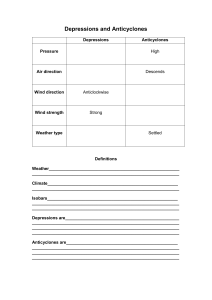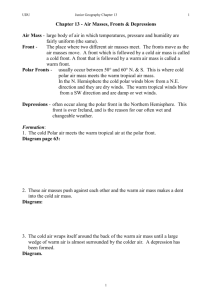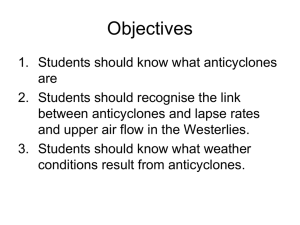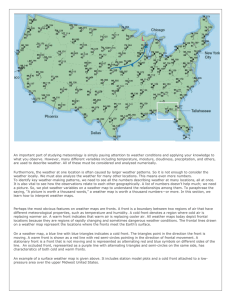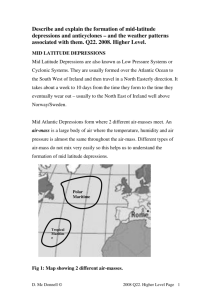Anticyclones & Depressions
advertisement
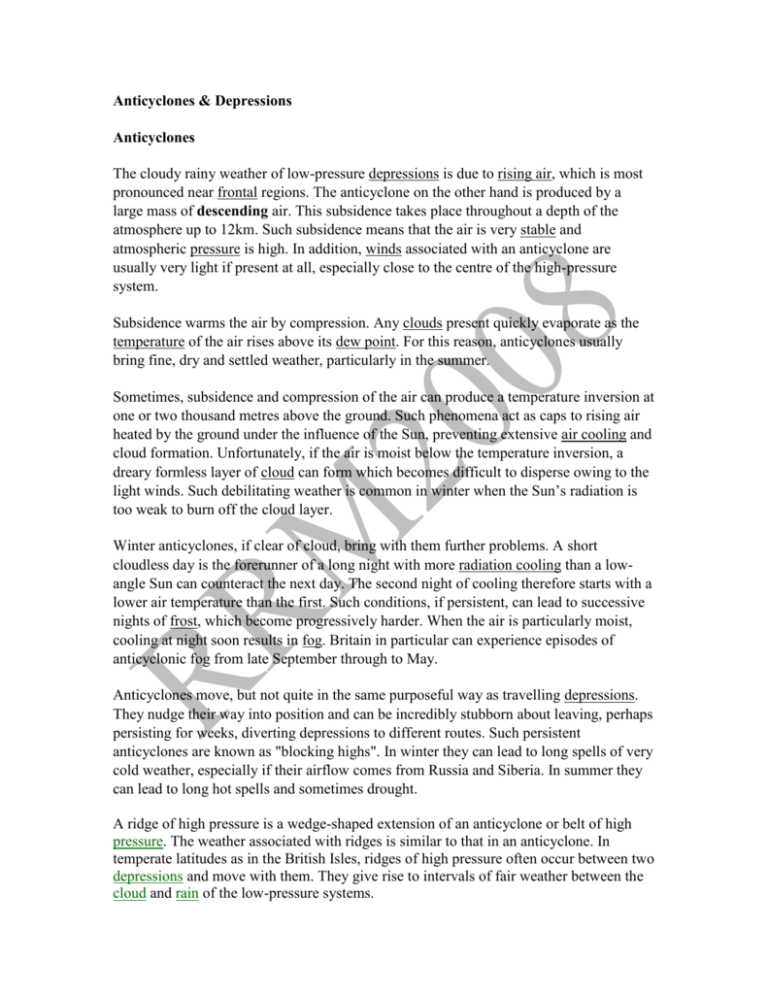
Anticyclones & Depressions Anticyclones The cloudy rainy weather of low-pressure depressions is due to rising air, which is most pronounced near frontal regions. The anticyclone on the other hand is produced by a large mass of descending air. This subsidence takes place throughout a depth of the atmosphere up to 12km. Such subsidence means that the air is very stable and atmospheric pressure is high. In addition, winds associated with an anticyclone are usually very light if present at all, especially close to the centre of the high-pressure system. Subsidence warms the air by compression. Any clouds present quickly evaporate as the temperature of the air rises above its dew point. For this reason, anticyclones usually bring fine, dry and settled weather, particularly in the summer. Sometimes, subsidence and compression of the air can produce a temperature inversion at one or two thousand metres above the ground. Such phenomena act as caps to rising air heated by the ground under the influence of the Sun, preventing extensive air cooling and cloud formation. Unfortunately, if the air is moist below the temperature inversion, a dreary formless layer of cloud can form which becomes difficult to disperse owing to the light winds. Such debilitating weather is common in winter when the Sun’s radiation is too weak to burn off the cloud layer. Winter anticyclones, if clear of cloud, bring with them further problems. A short cloudless day is the forerunner of a long night with more radiation cooling than a lowangle Sun can counteract the next day. The second night of cooling therefore starts with a lower air temperature than the first. Such conditions, if persistent, can lead to successive nights of frost, which become progressively harder. When the air is particularly moist, cooling at night soon results in fog. Britain in particular can experience episodes of anticyclonic fog from late September through to May. Anticyclones move, but not quite in the same purposeful way as travelling depressions. They nudge their way into position and can be incredibly stubborn about leaving, perhaps persisting for weeks, diverting depressions to different routes. Such persistent anticyclones are known as "blocking highs". In winter they can lead to long spells of very cold weather, especially if their airflow comes from Russia and Siberia. In summer they can lead to long hot spells and sometimes drought. A ridge of high pressure is a wedge-shaped extension of an anticyclone or belt of high pressure. The weather associated with ridges is similar to that in an anticyclone. In temperate latitudes as in the British Isles, ridges of high pressure often occur between two depressions and move with them. They give rise to intervals of fair weather between the cloud and rain of the low-pressure systems. Depressions Depressions, sometimes called mid-latitude cyclones, are areas of low pressure located between 30° and 60° latitude. Depressions develop when warm air from the sub-tropics meets cold air from the Polar Regions. There is a favourite meeting place in the midAtlantic for cold polar air and warm sub-tropical air. Depressions usually have well defined warm and cold fronts, as the warm air is forced to rise above the cold air. Fronts and depressions have a birth, lifetime and death; and according to the stage at which they are encountered, so does the weather intensity vary. A depression appears on a synoptic (weather) chart as a set of closed curved isobars with winds circulating anticlockwise in the Northern Hemisphere and clockwise in the Southern Hemisphere due to the rotation of the Earth. The warm and cold fronts associated with depressions bring with them characteristically unsettled weather. Depressions vary from between 200 and 2,000 miles in diameter; they may be deep when pressure at their centre is very low and the isobars are tightly packed, or shallow when less well developed. A depression develops like the propagation of a wave in water. Initially, a uniform boundary or front exists between cold air pushing southwards and warm air pushing northwards (in the Northern Hemisphere). A wave-shaped distortion may appear on the front, and a small low-pressure centre develops at the crest of the wave. In the immediately surrounding area the pressure begins to fall. A disturbance of this kind is called a wave depression. As the "wave" develops, a warm sector of air forms bounded by the warm and cold fronts, which begins to tie over the engulfing cold air. Both the warm and cold fronts originate from the centre of the depression. On the ground, sudden changes in the wind direction may be experienced when fronts pass by. Wave depressions can grow off the tail ends of primary cold fronts. The depression so formed is then called a secondary depression. New centres may also develop from occluded fronts within the primary depression. The secondary system can then become the main system, and the primary occluded front becomes caught up in the developing circulation, effectively becoming a third front. Schematic development of a Depression
